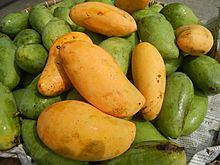Pico (mango) facts for kids
Quick facts for kids Mangifera 'Pico' |
|
|---|---|

Ripe and unripe pico mangoes from Bulacan
|
|
| Genus | Mangifera |
| Cultivar | 'Pico' |
| Marketing names | Piko Padero |
| Origin | Philippines |
The Pico mango (also called piko) is a special type of mango from the Philippines. It is also known as padero. This mango is one of the most popular kinds grown in the Philippines. It is often grown alongside the famous Carabao mango.
Contents
What Makes Pico Mangoes Special?
Shape and Size
Pico mangoes have a unique shape. They are long and thin. These mangoes can grow up to 12.5 centimetres (4.9 in) in length. But they are only about 8 cm (3.1 in) wide. They look much flatter than the rounder Carabao mangoes.
Color and Taste
When a Pico mango is ripe, its skin turns a pale yellow or light orange color. The inside flesh is a rich orange. It often becomes reddish near the tips. This part of the mango is very sweet. The flesh is soft, but it is not as soft as the Carabao mango.
How Pico Mangoes Grow
Reproduction and Seeds
Pico mangoes are like other mangoes from Southeast Asia. They are polyembryonic. This means that one seed can grow into more than one plant. This is different from Indian-type mangoes, where one seed usually grows into only one plant.
When to Find Them
You can usually find Pico mangoes during their fruiting season. This is from May to July. During these months, the trees are full of ripe and delicious mangoes.

